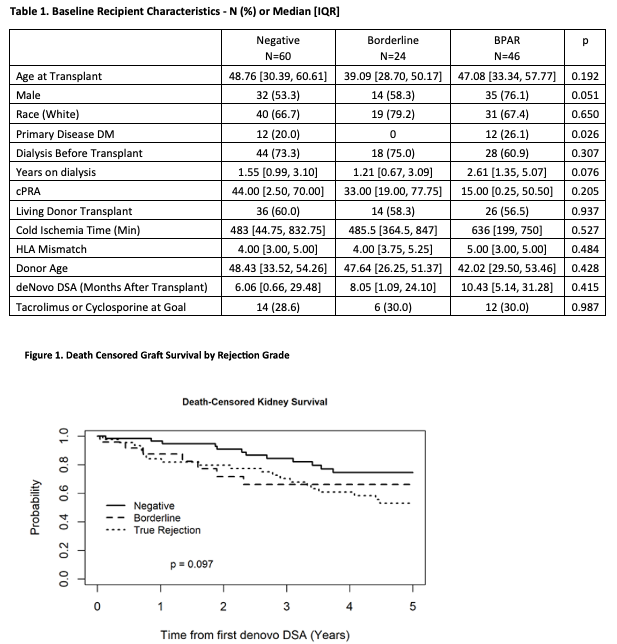Kidney Transplant Survival After Borderline Rejection in the Setting of Denovo Dsa Formation
1Department of Nephrology, University of Minnesota, Minneapolis, MN, 2Biostatistics, M-Health Fairview Analytics, Minneapolis, MN
Meeting: 2021 American Transplant Congress
Abstract number: 888
Keywords: Biopsy, Graft survival, Kidney transplantation, Rejection
Topic: Clinical Science » Kidney » Kidney: Acute Cellular Rejection
Session Information
Session Name: Kidney: Acute Cellular Rejection
Session Type: Poster Abstract
Session Date & Time: None. Available on demand.
Location: Virtual
*Purpose: The significance of borderline cellular rejection has been questioned in the past. Data on borderline rejection with deNovo DSA (dnDSA) formation is limited. We sought to evaluate the outcome of borderline rejection detected after the appearance of dnDSA.
*Methods: Retrospective review of adult primary kidney alone transplant recipients of either living or deceased donor at our center since 2000 who received depletional induction with thymoglobulin 6mg/kg and early steroid withdrawal that survived >1 month with allograft, found to have dnDSA and had kidney transplant biopsy within 2 months of dnDSA discovery. We grouped recipients by rejection grade into 3 groups: no rejection (n=60), borderline rejection (n=24) and definitive rejection group defined as rejection other than borderline (BPAR) (n=46). Kaplan-Meier curves were generated for death censored graft Survival (DCGS) by rejection grade with follow up censored at 5-years post dnDSA discovery.We used Cox proportional hazard model to examine the association between rejection grade and death censored graft survival. Model was adjusted for HLA-MM, Race, BMI, donor type and age.
*Results: Baseline characteristics are listed in Table 1. Greater than 70% of patients had a subtherapeutic CNI level in the month preceding biopsy. In the Kaplan-Meier analysis, death censored graft survival was not statistically different by rejection grade among recipients with dnDSA formation (Figure 1). In the multivariable Cox proportional hazards model for DCGS, compared to the no rejection group, borderline rejection was not found to be a significant predictor of graft loss [HR 2.9, 95% C.I. (0.48, 17.2) p=0.25], while BPAR was associated with a 5.7-fold increased risk of graft loss among dnDSA forming recipients [HR 5.7, 95% C.I. (1.756, 18.415), p=0.004].
*Conclusions: In this small sample of transplant recipients with dnDSA formation who underwent diagnostic biopsy, borderline rejection was not a significant predictor of graft loss as compared to recipient without rejection.
To cite this abstract in AMA style:
Bregman AP, Jackson S, Riad S. Kidney Transplant Survival After Borderline Rejection in the Setting of Denovo Dsa Formation [abstract]. Am J Transplant. 2021; 21 (suppl 3). https://atcmeetingabstracts.com/abstract/kidney-transplant-survival-after-borderline-rejection-in-the-setting-of-denovo-dsa-formation/. Accessed December 16, 2025.« Back to 2021 American Transplant Congress

